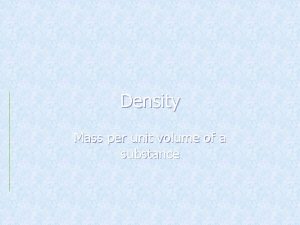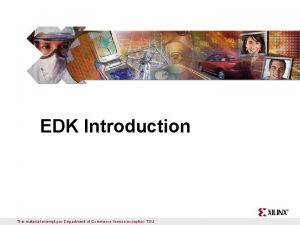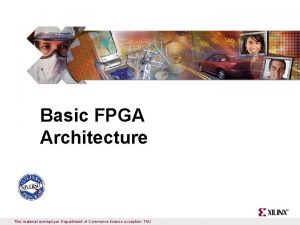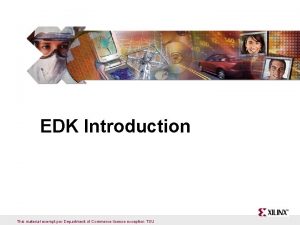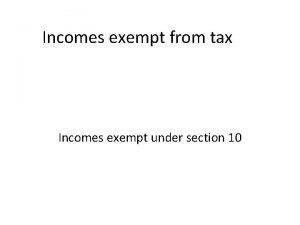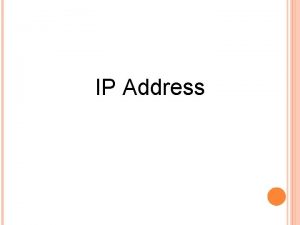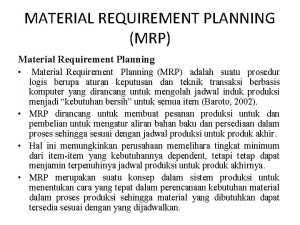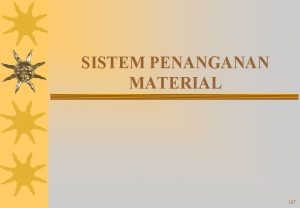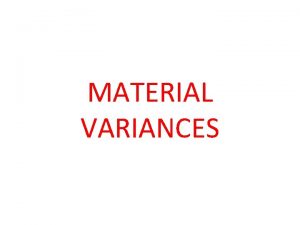Address Management This material exempt per Department of












![Sections Example int ram_data[10] = {0, 1, 2, 3, 4, 5, 6, 7, 8, Sections Example int ram_data[10] = {0, 1, 2, 3, 4, 5, 6, 7, 8,](https://slidetodoc.com/presentation_image_h/eb3fdcbbbdaa4da2acbb86fe98ce17cc/image-13.jpg)











- Slides: 24

Address Management This material exempt per Department of Commerce license exception TSU

Objectives After completing this module, you will be able to: • Describe address management for Power. PC processors Define a system address space Define an advanced user address space Describe the object file sections Describe what a linker script does • • 2

Outline • Address Management • System Address Space • Advanced User Address Space • Object File Sections • Linker Scripts 3

Address Management • Embedded processor design requires you to manage the following: – Address map for the peripherals – Location of the application code in the memory space • Block RAM • External memory • Memory requirements for your programs are based on the following: – The amount of memory required for storing the instructions – The amount of memory required for storing the data associated with the program

Power. PC Processor • Memory and peripherals – PPC 405 uses 32 -bit addresses • Special addresses 0 x. FFFF_FFFC Reset Address PLB/OPB Memory 0 x. FFFF_0000 – Every Power. PC™ system should have the boot section starting at 0 x. FFFFFFFC PLB/OPB Memory • Default linker options – Program space occupies a contiguous address space from 0 x. FFFF 0000 to 0 x. FFFF – Stack size: 4 KB – Heap size: 4 KB Peripherals 0 x 0000_0000

Outline • Address Management • System Address Space • Object File Sections • Linker Scripts 6

Advanced User Address Space • Different base address, contiguous user address space – The user program can run from any memory PLB, OCM, OPB, or LMB – To execute a program from any address location other than default, you must provide the compiler gcc with a Program Start Address

Advanced User Address Space • Different base address, noncontiguous user address space – You can place different components of your program in different memories • For example, on Power. PC systems, you can keep your code on instruction cache memory and the data on ZBT memory – Noncontiguous executables that represent the application must be created – To do this, a linker script must be used

Outline • Address Management • Advanced User Address Space • Object File Sections • Linker Scripts 9

Object File Sections • What is an object file? – An object file is an assembled piece of code • Machine language: li r 31, 0 = 0 x 3 BE 0 0000 – Constant data – There may be references to external objects that are defined elsewhere – This file may contain debugging information

Object File Sections 11 . text Text section . rodata Read-only data section . sdata 2 Small read-only data section (less than eight by . data Read-write data section . sdata Small read-write data section . sbss Small uninitialized data section . bss Uninitialized data section

Object File Sections 12 . init Language initialization code . fini Language cleanup code . ctors List of functions to be invoked at program startu . dtors List of functions to be invoked at program end . got 2 Pointers to program data . got Pointers to program data . eh_frame Frame unwind information for exception handlin
![Sections Example int ramdata10 0 1 2 3 4 5 6 7 8 Sections Example int ram_data[10] = {0, 1, 2, 3, 4, 5, 6, 7, 8,](https://slidetodoc.com/presentation_image_h/eb3fdcbbbdaa4da2acbb86fe98ce17cc/image-13.jpg)
Sections Example int ram_data[10] = {0, 1, 2, 3, 4, 5, 6, 7, 8, 9}; /* DATA */ const int rom_data[10] = {9, 8, 7, 6, 5, 4, 3, 2, 1}; /* RODATA */ int I; /* BSS */ main(){. . . I = I + 10; . . . } 13 /* TEXT */

Outline • • 14 Address Management System Address Space Object File Sections Linker Scripts

Linker Scripts • Linker scripts – Control the linking process – Map the code and data to a specified memory space – Set the entry point to the executable – Reserve space for the stack • Required if the design contains a discontinuous memory space 15

Linker and Locator Flows foo 1. o. text 1 foo 2. o. text 2. data 2. bss 2 16 0 x. FFF F Code . text . data 1. bss 1 Executable Image Merged Output Section s Locat e Link . data. bss 0 x. F 00 0 0 x. EFF Funinitialized data 0 x. EF 0 0 0 x. EEF F Unuse d 0 x 200 0 0 x 1 FF F Initialized data 0 x 000 0

Power. PC Processor Script Example STACKSIZE = 4 k; MEMORY { ddr : ORIGIN = 0 x 0000, LENGTH = 32 m sram : ORIGIN = 0 x 10000000, LENGTH = 2 m flash : ORIGIN = 0 x 18000000, LENGTH = 32 m bram : ORIGIN = 0 xffff 8000, LENGTH = 32 k - 4 boot : ORIGIN = 0 xfffffffc, LENGTH = 4 } SECTIONS {. text : { *(. text) } > bram. boot : { *(. boot) } > boot. data : { *(. data) *(. got 2) *(. rodata) *(. fixup)} > bram. bss : { *(. bss) } > bram __bss_start = ADDR(. bss); __bss_end = ADDR(. bss) + SIZEOF(. bss); } 19

Sections Command • This is where most of the work takes place • Output sections are named, and the input sections are grouped and linked together into the output sections • Example: . text : { *(. text) *(. init) } > bram • Explanation: –. text is the name of the output section – { *(. text) *. (init) } includes all input sections named text and init from the object files being linked – > bram locates the. text output section in the next available memory 20 in the block RAM area

Linker Script Generator GUI • XPS contains a graphical Linker Script Generator • Table-based GUI allows you to define the memory space for any section • Launch from Software → Generate Linker Script, or from the Applications Tab, rightclick on <project> → Generate Linker Script • The tool will create a new linker script (the 21 old script is backed up)

Knowledge Check • When do you need to use a linker script? • What does a linker script do? 22

Answers • When do you need to use a linker script? – When you have software developed in multiple source files and the compiled object code needs to be placed in different memory structures or in nonstandard configurations • What does a linker script do? – The linker script controls the placement of the object code, data, stack, and heap in specific memory locations 23

Knowledge Check • What does. sdata 2 section contain? • What does. sdata section contain? • What does. sbss section contain? 24

Answers • What does. sdata 2 section contain? – Small read-only data • What does. sdata section contain? – Small read-write data • What does. sbss section contain? – Small uninitialized data 25

Where Can I Learn More? • Tool documentation – Embedded System Tools Guide Address Management – Embedded Systems Tools Guide Stand-Alone Board Support Package – Embedded Systems Tools Guide GNU Compiler Tools • Support Website – EDK Website: www. xilinx. com/edk – GNU Website: http: //gcc. gnu. org/onlinedocs/gcc 3. 4. 4/gcc
 Memory swaping
Memory swaping Persons exempt from vat
Persons exempt from vat What is mean by virgin
What is mean by virgin Are local governments tax exempt
Are local governments tax exempt Are city governments tax exempt
Are city governments tax exempt Non assessable income meaning
Non assessable income meaning Exempt development code
Exempt development code Gsa tax exempt form florida
Gsa tax exempt form florida E595 tax exempt form
E595 tax exempt form Virtual condition in gd&t
Virtual condition in gd&t Material yield variance formula
Material yield variance formula Cultural relativism
Cultural relativism Non material culture examples
Non material culture examples Material and non material culture examples
Material and non material culture examples Useful and harmful household materials
Useful and harmful household materials Mass per unit volume of a substance
Mass per unit volume of a substance Moltiplicazioni con numeri periodici
Moltiplicazioni con numeri periodici Coop per me e per te
Coop per me e per te Una voce il mio diletto
Una voce il mio diletto Kruta ir kruta braska ir braska
Kruta ir kruta braska ir braska 27 miles per gallon into kilometers per liter
27 miles per gallon into kilometers per liter 1 hour 1 minute 1 second
1 hour 1 minute 1 second Rohmat pergi ke tasikmalaya menggunakan sepeda motor
Rohmat pergi ke tasikmalaya menggunakan sepeda motor Per stirpes v per capita
Per stirpes v per capita Multas per gentes et multa per aequora vectus
Multas per gentes et multa per aequora vectus















